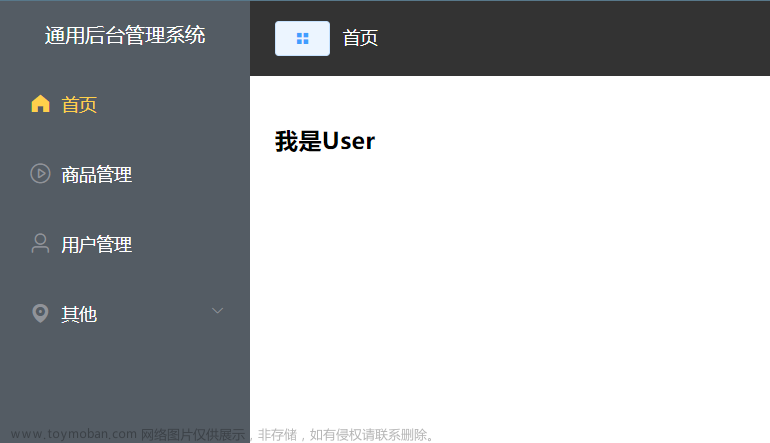知识补充
yarn和npm区别
npm的缺点:
- npm install时候巨慢
- 同一个项目,安装的时候无法保持一致性。 由于package.json文件中版本号的特点。
“5.0.3” 安装指定的5.0.3版本
“~5.0.3” 表示安装5.0.X中最新的版本
“^5.0.3” 表示安装5.X.X中最新的版本
有时候会出现版本不一致不能运行的情况。
yarn的优点
- 速度快
并行安装:同步执行所有任务,不像npm按照队列执行每个package,package安装不完成,后面也无法执行。
离线模式:安装过得软件包,直接从缓存中获取,不用像npm从网络中获取。 - 安装版本统一
- 更简洁的输出:
npm输出所有被安装上的依赖,但是yarn只打印必要的信息 - 多注册来源处理:安装某个包,只会从一个注册来源去安装,
- 更好的语义化,yarn安装和卸载是yarn add/remove,npm是npm install/uninstall
npm查看镜像和设置镜像
npm config get registry
npm config set registry https://registry.npmmirror.com/
项目介绍
项目演示

项目的技术栈

- 使用yarn安装vue-cli
yarn global add @vue/cli
项目搭建
先vue create创建一个项目,然后安装element-ui组件和vue-router,less等组件
文件目录

创建路由,引入element-ui
router/index.js
import VueRouter from "vue-router";
import Login from "@/pages/Login.vue";
import Users from "@/pages/Users.vue";
import Main from '@/pages/Main.vue'
import Home from "@/pages/Home.vue";
const router= new VueRouter({
// 浏览器模式设置,设置为history模式
mode:'history',
routes:[
{
path:"/login",
component:Login,
meta:{title:"登录"},
},
{
// 主路由
name:"main",
path:'/',
component:Main,
children:[ //子路由
{
name:"users",
path:"users",
component:Users,
meta:{title:"用户"}
},
{
name:"home",
path:"home",
component:Home,
meta:{title:"主页"}
}
]
}
]
})
// 后置路由守卫
router.afterEach((to,from)=>{
document.title=to.meta.title||"通用后台管理系统"
})
export default router
main.js
import Vue from 'vue'
import App from './App.vue'
import VueRouter from "vue-router";
import router from "@/router";
import ElementUI from 'element-ui';
import 'element-ui/lib/theme-chalk/index.css'
Vue.config.productionTip = false
Vue.use(VueRouter)
Vue.use(ElementUI)
new Vue({
router,
render: h => h(App),
}).$mount('#app')
pages/Users.vue
<template>
<div>
我是Users组件
</div>
</template>
<script>
export default {
name: "Users",
}
</script>
<style scoped>
</style>
pages/Main.vue
<template>
<div>
<h1>main</h1>
<router-view></router-view>
</div>
</template>
<script>
export default {
name: "Main",
}
</script>
<style scoped>
</style>
pages/Home.vue
<template>
<div>
home内容
</div>
</template>
<script>
export default {
name: "Home",
}
</script>
<style scoped>
</style>
pages/Login.vue
<template>
<div id="app">
<div class="main-content">
<div class="title">系统登录</div>
<div class="content">
<el-form :model="ruleForm" status-icon :rules="rules" ref="ruleForm" label-width="100px" class="demo-ruleForm">
<el-form-item label="用户名" prop="name">
<el-input v-model="ruleForm.name" ></el-input>
</el-form-item>
<el-form-item label="密码" prop="password">
<el-input v-model="ruleForm.password" type="password" autocomplete="off"></el-input>
</el-form-item>
<el-form-item>
<el-row :gutter="20">
<el-col :span="12" :offset="4"><router-link to="/login"><el-button type="primary" @click="submitForm('ruleForm')">登录</el-button></router-link></el-col>
</el-row>
</el-form-item>
</el-form>
</div>
</div>
</div>
</template>
<script>
export default {
name: "login",
data(){
return{
ruleForm: {
name: '',
password:""
},
rules: {
name: [
{required: true, message: '请输入用户名', trigger: 'blur'},
{min: 3, max: 5, message: '长度在 3 到 5 个字符', trigger: 'blur'}
],
password: [
{required:true,message:"请输入密码",trigger:"blur"}
]
}
}
},
methods:{
submitForm(formName) {
this.$refs[formName].validate((valid) => {
if (valid) {
// alert('submit!');
} else {
console.log('error submit!!');
return false;
}
});
},
}
}
</script>
<style lang="less" scoped>
*{
padding: 0;
margin: 0;
}
#app {
display: flex;
background-color: #333;
height: 800px;
.main-content{
height: 300px;
width: 400px;
background-color: #fff;
margin: 200px auto;
border-radius: 10px;
padding: 30px;
box-sizing: border-box;
box-shadow: 5px 5px 10px rgba(0,0,0,0.5),-5px -5px 10px rgba(0,0,0,0.5);
.title{
font-size: 20px;
text-align: center;
//margin-top: 30px;
font-weight: 300;
}
.content{
margin-top: 30px;
}
}
}
</style>
App.vue
<template>
<div id="app">
<router-view></router-view>
</div>
</template>
<script>
export default {
name: 'App',
}
</script>
<style lang="less">
*{
padding: 0;
margin: 0;
}
</style>

使用element-ui搭建主页样式
main页面布局使用这个


Main.vue
<template>
<div>
<el-container>
<el-aside width="200px">Aside</el-aside>
<el-container>
<el-header>Header</el-header>
<el-main>
<router-view></router-view>
</el-main>
</el-container>
</el-container>
</div>
</template>
<script>
export default {
name: "Main",
}
</script>
<style scoped>
</style>

导航栏使用

导航栏适配
Main.vue
<template>
<div>
<el-container>
<el-aside width="200px">
<CommonAside></CommonAside>
</el-aside>
<el-container>
<el-header>Header</el-header>
<el-main>
<!-- 路由出口,路由匹配到的组件将渲染在这里 -->
<router-view></router-view>
</el-main>
</el-container>
</el-container>
</div>
</template>
<script>
import CommonAside from "@/components/CommonAside.vue";
export default {
name: "Main",
components:{CommonAside}
}
</script>
<style scoped>
</style>
App.vue
<template>
<div id="app">
<router-view></router-view>
</div>
</template>
<script>
export default {
name: 'App',
}
</script>
<style lang="less">
html,body,h3{
padding: 0;
margin: 0;
}
</style>
CommonAside
<template>
<el-menu default-active="1-4-1" class="el-menu-vertical-demo" @open="handleOpen" @close="handleClose"
:collapse="isCollapse" background-color="#545c64" text-color="#fff"
active-text-color="#ffd04b">
<h3>通用后台管理系统</h3>
<el-menu-item index="2" v-for="item in noChildren" :key="item.name" :index="item.name">
<i :class="`el-icon-${item.icon}`"></i>
<span slot="title">{{item.label}}</span>
</el-menu-item>
<el-submenu :index="item.label" v-for="item in hasChildren" :key="item.label">
<template slot="title">
<i :class="`el-icon-${item.icon}`"></i>
<span slot="title">{{item.label}}</span>
</template>
<el-menu-item-group>
<el-menu-item :index="subItem.path" :key="subItem.path" v-for="subItem in item.children">
{{subItem.label}}
</el-menu-item>
</el-menu-item-group>
</el-submenu>
</el-menu>
</template>
<style lang="less" scoped>
.el-menu-vertical-demo:not(.el-menu--collapse) {
width: 200px;
min-height: 400px;
}
.el-menu{
height: 100vh; //占据页面高度100%
h3{
color: #fff;
text-align: center;
line-height: 48px;
font-size: 16px;
font-weight: 400;
}
}
</style>
<script>
export default {
data() {
return {
isCollapse: false,
menuData:[
{
path:'/',
name:"home",
label:"首页",
icon:"s-home",
url:'Home/Home'
},
{
path:'/mail',
name:"mall",
label:"商品管理",
icon:"video-play",
url:'MallManage/MallManage'
},
{
path:'/user',
name:"user",
label:"用户管理",
icon:"user",
url:'userManage/userManage'
},
{
label:"其他",
icon:"location",
children:[
{
path:'/page1',
name:"page1",
label:"页面1",
icon:"setting",
url:'Other/PageOne'
},
{
path:'/page2',
name:"page2",
label:"页面2",
icon:"setting",
url:'Other/PageTwo'
},
]
},
]
};
},
methods: {
handleOpen(key, keyPath) {
console.log(key, keyPath);
},
handleClose(key, keyPath) {
console.log(key, keyPath);
}
},
computed:{
//没有子菜单的数据
noChildren(){
return this.menuData.filter(item=>!item.children)
},
hasChildren(){
return this.menuData.filter(item=>item.children)
}
//有子菜单数组
}
}
</script>

导航栏跳转
文件目录
 文章来源:https://www.toymoban.com/news/detail-681266.html
文章来源:https://www.toymoban.com/news/detail-681266.html
src/router/index.js
import VueRouter from "vue-router";
import Login from "@/pages/Login.vue";
import Users from "@/pages/Users.vue";
import Main from '@/pages/Main.vue'
import Home from "@/pages/Home.vue";
import Mall from "@/pages/Mall.vue";
import PageOne from "@/pages/PageOne.vue";
import PageTwo from "@/pages/PageTwo.vue";
const router= new VueRouter({
// 浏览器模式设置,设置为history模式
// mode:'history',
routes:[
{
path:"/login",
component:Login,
meta:{title:"登录"},
},
{
// 子路由
name:"main",
path:'/',
redirect:"/home", //重定向 当路径为/,则重定向home
component:Main,
children:[
{
name:"user",
path:"user",
component:Users,
meta:{title:"用户管理"}
},
{
name:"home",
path:"home",
component:Home,
meta:{title:"首页"}
},
{
name:"mall",
path:"mall",
component:Mall,
meta:{title:"商品管理"}
},
{
name:"page1",
path:"page1",
component:PageOne,
meta:{title:"页面1"}
},
{
name:"page2",
path:"page2",
component:PageTwo,
meta:{title:"页面2"}
}
]
}
]
})
// 后置路由守卫
router.afterEach((to,from)=>{
document.title=to.meta.title||"通用后台管理系统"
})
export default router
src/pages/Mall.vue
<template>
<div>
我是mall
</div>
</template>
<script>
export default {
name: "Mall",
}
</script>
<style scoped>
</style>
src/pages/pageOne.vue
<template>
<div>
我是PageOne
</div>
</template>
<script>
export default {
name: "PageOne",
}
</script>
<style scoped>
</style>
src/pages/PageTwo.vue
<template>
<div>
我是PageTwo
</div>
</template>
<script>
export default {
name: "PageTwo",
}
</script>
<style scoped>
</style>
src/components/CommonAside.vue
<template>
<el-menu default-active="1-4-1" class="el-menu-vertical-demo" @open="handleOpen" @close="handleClose"
:collapse="isCollapse" background-color="#545c64" text-color="#fff"
active-text-color="#ffd04b">
<h3>通用后台管理系统</h3>
<el-menu-item @click="clickMenu(item)" v-for="item in noChildren" :key="item.name" :index="item.name">
<i :class="`el-icon-${item.icon}`"></i>
<span slot="title">{{item.label}}</span>
</el-menu-item>
<el-submenu :index="item.label" v-for="item in hasChildren" :key="item.label">
<template slot="title">
<i :class="`el-icon-${item.icon}`"></i>
<span slot="title">{{item.label}}</span>
</template>
<el-menu-item-group>
<el-menu-item @click="clickMenu(subItem)" :index="subItem.path" :key="subItem.path" v-for="subItem in item.children">
{{subItem.label}}
</el-menu-item>
</el-menu-item-group>
</el-submenu>
</el-menu>
</template>
<style lang="less" scoped>
.el-menu-vertical-demo:not(.el-menu--collapse) {
width: 200px;
min-height: 400px;
}
.el-menu{
height: 100vh; //占据页面高度100%
h3{
color: #fff;
text-align: center;
line-height: 48px;
font-size: 16px;
font-weight: 400;
}
}
</style>
<script>
export default {
data() {
return {
isCollapse: false,
menuData:[
{
path:'/',
name:"home",
label:"首页",
icon:"s-home",
url:'Home/Home'
},
{
path:'/mall',
name:"mall",
label:"商品管理",
icon:"video-play",
url:'MallManage/MallManage'
},
{
path:'/user',
name:"user",
label:"用户管理",
icon:"user",
url:'userManage/userManage'
},
{
label:"其他",
icon:"location",
children:[
{
path:'/page1',
name:"page1",
label:"页面1",
icon:"setting",
url:'Other/PageOne'
},
{
path:'/page2',
name:"page2",
label:"页面2",
icon:"setting",
url:'Other/PageTwo'
},
]
},
]
};
},
methods: {
handleOpen(key, keyPath) {
console.log(key, keyPath);
},
handleClose(key, keyPath) {
console.log(key, keyPath);
},
clickMenu(item){
// console.log(item)
this.$router.push(item.path)
}
},
computed:{
//没有子菜单的数据
noChildren(){
return this.menuData.filter(item=>!item.children)
},
//有子菜单数组
hasChildren(){
return this.menuData.filter(item=>item.children)
}
}
}
</script>
 文章来源地址https://www.toymoban.com/news/detail-681266.html
文章来源地址https://www.toymoban.com/news/detail-681266.html
到了这里,关于Vue2项目练手——通用后台管理项目第一节的文章就介绍完了。如果您还想了解更多内容,请在右上角搜索TOY模板网以前的文章或继续浏览下面的相关文章,希望大家以后多多支持TOY模板网!














